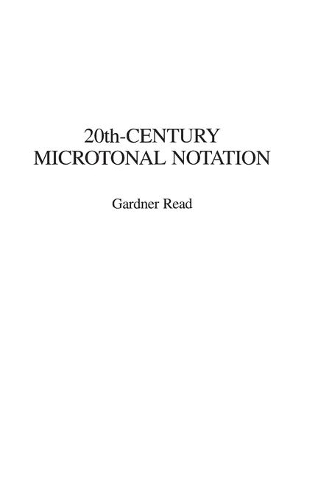
20th-Century Microtonal Notation
(Hardback)
Publishing Details
20th-Century Microtonal Notation
By (Author) Gardner Read
Bloomsbury Publishing PLC
Praeger Publishers Inc
18th July 1990
United States
Classifications
Tertiary Education
Non Fiction
780.148
Physical Properties
Hardback
208
Width 156mm, Height 235mm
454g
Description
No other book has covered the subject of 20th-century microtonal notation in such depth as this comprehensive guide book. 20th-Century Microtonal Notation surveys the many attempts to notate various microtonal divisions of the octave in our western music. The concerts, festivals, and journals devoted exclusively to microtonal composition evince the widespread interest and involvement in microtonal music today. Activity in the specialized field of microtonalism is also supported by the design and construction of a number of novel instruments capable of producing various fractional pitches in the octave, including the digital synthesizer. However, despite the developing interest and activity, no consensus has yet been reached about the clearest and most logical notation for each degree of microtonal division of the half and whole step. This lack of an essential consensus on a suitable, standardized notation system has, in some cases, hampered the complete integration of microtonalism into western music. Bringing considerable expertise to bear, Read divides the volume into five sections, each addressing the notation of specific microtones. This volume is a comprehensive repository of the many attempts to find a logical notation for all degrees of microtonality. It represents an invaluable resource to anyone interested in studying the history and development of music notation, or in evaluating the many forms of microtonal notation in terms of their potential for contemporary notation. 20th-Century Microtonal Notation will be an important addition to the library collections of colleges and universities and will be of interest to composers, theorists, performers, and musicologists.
Reviews
No less a figure than Igor Stravinsky observed, shortly before his death, that he believed the expansion of intonation and pitch would characterize the next stage of development in Western art music. Read's new book brings us up to the moment on the history of, and current conditions in, the exploitation and notation of microtonal music. Exhaustive in coverage, free from judgmental views, clear and definitive in presenting the problems and possibilities of microtonal music and notation, Read's work is as thorough and authoritative a consideration of the field as we are likely to see. Drawing upon examples from an impressive list of composers living and dead, Read discusses the fundamental problems with microtones: how to accommodate microtonal notation to established diatonic and chromatic notational norms, which octave-divisions to exploit, and how to persuade the many composers working with microtones to agree upon a single notational method. Read leaves no doubt that the problems are daunting and thus far largely unresolved, but his predictions of likely avenues for development in the near future seem sensible and possible of achievement. The book is well printed, contains a lengthy bibliography and index, and is remarkably free from typographical error, no mean feat in a work of such complexity. If there is as yet no overpowering literature of microtonal music, Read's study demonstrates that many excellent musicians are laboring in the vineyard of the microtone. In the spirit of Mr. Micawber, something is bound to turn up.-Choice
"No less a figure than Igor Stravinsky observed, shortly before his death, that he believed the expansion of intonation and pitch would characterize the next stage of development in Western art music. Read's new book brings us up to the moment on the history of, and current conditions in, the exploitation and notation of microtonal music. Exhaustive in coverage, free from judgmental views, clear and definitive in presenting the problems and possibilities of microtonal music and notation, Read's work is as thorough and authoritative a consideration of the field as we are likely to see. Drawing upon examples from an impressive list of composers living and dead, Read discusses the fundamental problems with microtones: how to accommodate microtonal notation to established diatonic and chromatic notational norms, which octave-divisions to exploit, and how to persuade the many composers working with microtones to agree upon a single notational method. Read leaves no doubt that the problems are daunting and thus far largely unresolved, but his predictions of likely avenues for development in the near future seem sensible and possible of achievement. The book is well printed, contains a lengthy bibliography and index, and is remarkably free from typographical error, no mean feat in a work of such complexity. If there is as yet no overpowering literature of microtonal music, Read's study demonstrates that many excellent musicians are laboring in the vineyard of the microtone. In the spirit of Mr. Micawber, something is bound to turn up."-Choice
Author Bio
GARDNER READ is Professor Emeritus, School for the Arts at Boston University. He is the author of six books, including Thesaurus of Orchestral Devices (Greenwood Press, 1969) and Source Book of Proposed Music Notation Reforms (Greenwood Press, 1987).
